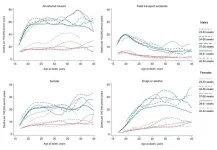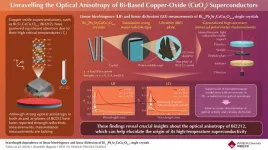(Press-News.org) SAN ANTONIO – Among patients with hormone receptor (HR)-positive, HER2-negative, low-risk ductal carcinoma in situ (DCIS), those who underwent active monitoring had similar two-year invasive ipsilateral breast cancer recurrence rates as those who underwent guideline-concordant treatment, according to results from the COMET clinical trial presented at the San Antonio Breast Cancer Symposium (SABCS), held December 10-13, 2024.
The results of this study were simultaneously published in JAMA.
“Active monitoring” is a strategy in which patients are monitored closely, with surgery reserved for those patients who develop cancer.
A steady increase in mammography and other breast cancer screening methods has led to the identification of more cases of DCIS, a noninvasive form of breast cancer. However, DCIS poses little risk to the patient unless it progresses to invasive disease, explained E. Shelley Hwang, MD, MPH, the Mary and Deryl Hart Distinguished Professor of Surgery, Vice-Chair of Research in the Department of Surgery, and a Professor of Radiology at the Duke University School of Medicine, who presented the study.
“All current treatments for DCIS aim to reduce the risk of future invasive cancer, despite a growing body of evidence that not all DCIS is destined to progress,” Hwang said. “Thus, current practice may result in the overtreatment of women whose tumors are at low risk of progression, leading to chronic pain, altered body image, reduced quality of life, and other side effects that may be avoidable.”
The COMET team sought to assess whether active monitoring is as effective as upfront treatment among patients whose DCIS has a low risk of progressing to invasive cancer. They conducted a multicenter, randomized clinical trial that enrolled 995 patients with grade 1 or 2, HR-positive, HER2-negative DCIS with no evidence of invasive cancer. They randomly assigned 484 patients to undergo active monitoring and 473 patients to receive guideline-concordant care consisting of surgery with or without adjuvant radiation. Patients in the active monitoring arm could elect to have surgery at any time, and surgery was required if the tumor showed signs of invasive progression. Patients in both treatment arms were allowed the option to receive endocrine therapy.
After 24 months of follow-up, 27 patients in the guideline-concordant care arm and 19 in the active monitoring arm had been diagnosed with invasive ipsilateral (same breast) breast cancer. The two-year cumulative rate of invasive ipsilateral breast cancer was 5.9% in the guideline-concordant care arm and 4.2% in the active monitoring arm; the difference met the threshold for noninferiority, meaning that neither treatment was deemed inferior to the other.
Because 29% of patients overall did not adhere to their randomized treatment arm, the researchers performed a separate analysis of 673 patients who received their assigned treatment. The two-year rate of invasive ipsilateral breast cancer was 8.7% in the guideline-concordant care arm and 3.1% in the active monitoring arm.
Slightly more patients received endocrine therapy in the active monitoring arm compared to the guideline- concordant care arm—71.3% versus 65.5%, respectively. Among patients who received endocrine therapy, the rate of invasive ipsilateral cancer was 7.15% in the guideline-concordant care arm and 3.21% in the active monitoring arm.
Hwang noted that these results may help patients and their providers make informed decisions about DCIS treatment. “Omission of surgery has been highly controversial, with both patients and providers fearing that it might result in an unacceptably high rate of patients who develop invasive cancer,” Hwang said. “Our findings are reassuring, and longer-term follow up will have important implications for the future inclusion of active monitoring as a treatment option for low-risk DCIS.”
Limitations of this study include the inability to blind treatment arms to either the provider or the patient. Further, while the researchers prospectively balanced patient characteristics between the two treatment arms, differences in characteristics that were unaccounted for are possible.
Data on patient-reported outcomes from the COMET trial are available in another press release.
Funding for this study was provided by the Patient-Centered Outcomes Research Institute, the Breast Cancer Research Foundation, and Alliance Foundation Trials. Hwang declares no relevant conflicts of interest.
END
SAN ANTONIO – Patients with intermediate-risk breast cancer had similar rates of 10-year overall survival whether or not they underwent chest wall irradiation (CWI) after mastectomy, according to results from the BIG 2-04 MRC SUPREMO clinical trial presented at the San Antonio Breast Cancer Symposium (SABCS), held December 10-13, 2024.
“While post-mastectomy CWI is the standard of care for most patients with early-stage breast cancer who have four or more positive axillary lymph nodes, its role in patients with fewer positive lymph nodes or node-negative disease remains controversial,” ...
About The Study: Women with low-risk ductal carcinoma in situ randomized to active monitoring did not have a higher rate of invasive cancer in the same breast at 2 years compared with those randomized to guideline-concordant care.
Corresponding Author: To contact the corresponding author, E. Shelley Hwang, MD, MPH, email shelley.hwang@duke.edu.
To access the embargoed study: Visit our For The Media website at this link https://media.jamanetwork.com/
(doi:10.1001/jama.2024.26698)
Editor’s Note: Please ...
About The Study: In this prespecified secondary analysis of the Comparing an Operation to Monitoring, With or Without Endocrine Therapy (COMET) prospective randomized trial, the overall lived experience of women randomized to undergo active monitoring for low-risk ductal carcinoma in situ was similar to that of women randomized to guideline-concordant care during the 2 years following diagnosis.
Corresponding Author: To contact the corresponding author, Ann H. Partridge, MD, MPH, email ann_partridge@dfci.harvard.edu.
To access the embargoed study: Visit our For The Media website ...
Not only are they the smallest among us, premature children also face health and life challenges that make them the most vulnerable. Generally speaking, they have a slightly higher risk of mortality due to illness. It is now apparent that they also have a higher risk of unexpected death from so-called external causes: road traffic accidents, substance abuse and suicide.
This has been revealed in a major Nordic study led by Professor Kari Risnes from the Faculty of Medicine and Health Sciences at the Norwegian University of Science and Technology (NTNU). The researchers have analyzed birth data and causes of death for nearly 37,000 individuals aged between 15 ...
Petrovax announced today the positive results from “Long-CoV-III-21,” a randomized, double-blind, placebo-controlled trial evaluating the efficacy and safety of bovhyaluronidase azoximer in adult patients with pulmonary sequelae of COVID-19. Bovhyaluronidase azoximer, marketed under the brand name Longidaza, is a polymer-conjugated hyaluronidase with an extended half-life. The study drug and placebo were administered for 71 days, with an observation period extending to Day 180.
Longidaza demonstrated a statistically significant 62% reduction in the proportion of patients with exertional desaturation ...
Mosasaurs are extinct marine lizards, spectacular examples of which were first discovered in 1766 near Maastricht in the Netherlands, fueling the rise of the field of vertebrate palaeontology (the study of fossil remains of animals with backbones). Palaeontologist Michael Polcyn presented the most comprehensive study to date on the early evolution and ecology of these extinct marine reptiles. On 16 December, Polcyn will receive his PhD from Utrecht University for his research into the evolution of the mosasaurs. "Mosasaurs are a textbook example of macroevolution, ...
Genova (Italy), 12th December 2024 – A specific brain mechanism modulates how animals respond empathetically to others’ emotions. This is the latest finding from the research unit Genetics of Cognition, led by Francesco Papaleo, Principal Investigator at the Istituto Italiano di Tecnologia (IIT - Italian Institute of Technology) and affiliated with IRCCS Ospedale Policlinico San Martino in Genova. The study, recently published in Nature Neuroscience, provides new insights into psychiatric ...
The Korea Institute of Materials Science (KIMS) announced that Dr. Yong-Hun Kim from the Energy & Environment Materials Research Division and Dr. Kyung Song from the Material Characterization Center, in collaboration with Professor Hyun-Sang Hwang's team from POSTECH, have successfully developed a groundbreaking heterojunction technology. This technology integrates tungsten disulfide (WS₂), a two-dimensional (2D) material, with hafnium zirconium oxide (HZO), a ferroelectric material, achieving both interfacial stability and superior crystallinity. The results have been accepted by the International Electron Devices Meeting 2024 (IEDM 2024), ...
“Rich” and “full-bodied” are terms that people often use to describe the taste of wine. They are also the properties that kokumi compounds bring to foods like mature Gouda cheese, though scientists haven’t widely explored them in wines. In ACS’ Journal of Agricultural and Food Chemistry, researchers now connect the dots and report 11 probable kokumi compounds in sparkling wines.
Kokumi is often confused with the better-known term umami. Umami is a savory, meaty flavor and is one of the basic five tastes, along with sweet, ...
Superconductors are materials which conduct electricity without any resistance when cooled down below a critical temperature. These materials have transformative applications in various fields, including electric motors, generators, high-speed maglev trains, and magnetic resonance imaging. Among these materials, CuO2 superconductors like Bi2212 stand out due to their high critical temperatures that surpass the Bardeen–Cooper–Schrieffer limit, a theoretical maximum temperature limit for superconductivity. However, ...



